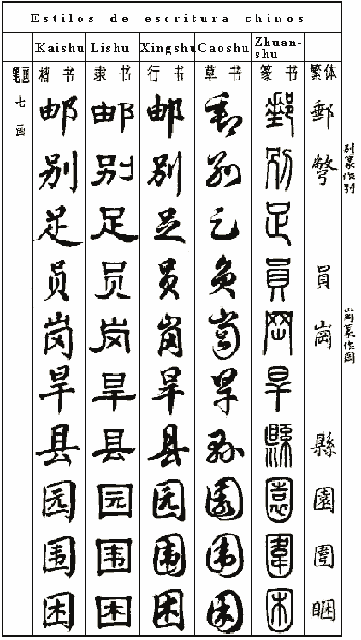http://dailylife2.abc-clio.com/
Luo, Jing. "Migrant Population in China: Modern World." Daily Life through History. ABC-CLIO, 2011. Web. 20 Sept. 2011.
“China spoken languages and the reform of Chinese script”
China has more than 100 spoken languages.
The spoken languages are related with the different ethnics that habit China.
These languages share the writing system but do not share the way they are reading.
Putonghua (Mandarin for the western countries):
1. Origin:
Came from the Han ethnic.
Han ethnic account for the 95% of the total population of China.
Uses ideographs known as Chinese characters.
2. Government Influence:
Establish as the official language spoken in China.
Alls civil servants should be able to communicate in Putonghua.
Set the Putonghua Test to determine a language user’s level of competence, which has become the Chinese equivalent of the Test of English as a Foreign Language (TOEFL).
3.Reform in Chinese Scripts:
3.1 Content:
Started to simplify many of the complicated Chinese characters.
3.2 Consist of three main points:
- Establish Putonghua as the standardized common language of instruction in schools and in the national media.
- Reducing the number of strokes of a character.
- Reducing the number of Chinese known as Pinyin, using the Roman alphabet.
3.3Results:
- The simplified writing system has become the standard system in the Republic of China.
- The International Standardization Organization (ISO) disposes Pinyin as the official system to transcribe Chinese before the government abandoned the Pinyin system.
Migrant Population:

Outline:
1.-The migrant population in China can be categorized into two groups:
a) The migrant population: those who must obtain governmental permission, undergo certain procedures of official household registration.
b) The floating population: those who engage in partial temporary relocation but maintain ties with their original place of abode.
2.-Three major flows of the migrant population have occurred since 1950.
a) The first two occurred during the 1960s and 1970s.
b) The third took place in the late 1990s.
3.-Net in-migration rates among regions:
a) The eastern regions: rose from 60% in 1955 to 70% in 1980.
b) The central provinces: went up from 67% in 1955 to 75% in 1980.
c) The western provinces: increased from 60% in 1955 to 71% in 1980.
4. - The characteristics of the migrant population in China are selective in:
4.1- Gender: the male migrant population outnumbers the female migrant population.
4.2- Age: the age group 20 to 24 was ranked first with about 38.6%, followed by the age group 15 to 19 with 18.7% and the age group 30 to 34 with 10.3%.
4.3- Occupation and educational: workers engaged in production and transportation were the most likely migrants, with 32.7%, laborers engaged in farming, forestry, animal husbandry, and fishery, with 31.2%, professional and technical personnel with 14.5% and people who were engaged in commerce and services with 11.7%.
5.-Occurrence and volume of the migrant population:
a) Characterized by selection, strict control, and limitation.
b) Determined by the country's social, economic, and political system.
6. Factors that affect the migrant population:
a) The central planning system.
b) The market system.
MLA:
Luo, Jing. "Migrant Population in China: Modern World." Daily Life through History. ABC-CLIO, 2011. Web. 22 Nov. 2011.
Ming, Xo. "Migrants in China:." Daily Life through History. ABC-CLIO, 2011. Web. 02 Nov. 2011.
A Good Fall : "In the Crossfire"
Vocabulary words:
1. Chitchat: Chat, talk.
2. Chore: task, work (without pay).
3. Berate: censure severely.
4. Mend: repair, correct.
5. Jinx: bring bad luck.
6. Endure: tolerate.
7. Grimaced: , make a face, to contort the face.
8. Hurl: to throw something with great force.
9. Fetch: bring, to pick up.
10. Snarl: growl.
Resume:
The story is about the life of a Chinese couple (Tian and Connie) that live in the United States. Connie is studying to become a nurse and Tian is working in a factory where some employees have gotten layoff. Tian invited his mother (Meifen) to come to visited them, and the problems come with her. Meifen start to give opinions about his son's wife and her opinions create problem between the couple. Meifen act like the owner of the house and Tian and Connie disagree with her attitude. Unable to find other solution to send her mother back to China, Tian talk to his boss to gave him layoff. He told his mother that he was unemployed and he has no money to pay for the trip if she decided to stay more time with them. Meifen decided to go back to China and the couple return to their normal live.
Ming, Xo. "Migrants in China:." Daily Life through History. ABC-CLIO, 2011. Web. 02 Nov. 2011.
A Good Fall : "In the Crossfire"
Vocabulary words:
1. Chitchat: Chat, talk.
2. Chore: task, work (without pay).
3. Berate: censure severely.
4. Mend: repair, correct.
5. Jinx: bring bad luck.
6. Endure: tolerate.
7. Grimaced: , make a face, to contort the face.
8. Hurl: to throw something with great force.
9. Fetch: bring, to pick up.
10. Snarl: growl.
Resume:
The story is about the life of a Chinese couple (Tian and Connie) that live in the United States. Connie is studying to become a nurse and Tian is working in a factory where some employees have gotten layoff. Tian invited his mother (Meifen) to come to visited them, and the problems come with her. Meifen start to give opinions about his son's wife and her opinions create problem between the couple. Meifen act like the owner of the house and Tian and Connie disagree with her attitude. Unable to find other solution to send her mother back to China, Tian talk to his boss to gave him layoff. He told his mother that he was unemployed and he has no money to pay for the trip if she decided to stay more time with them. Meifen decided to go back to China and the couple return to their normal live.
